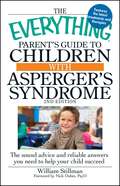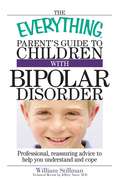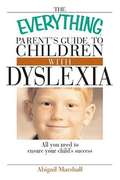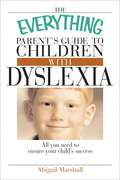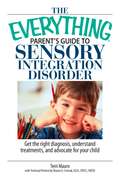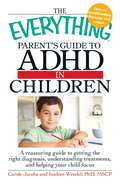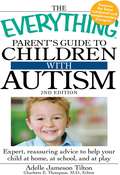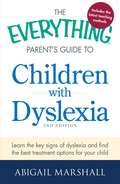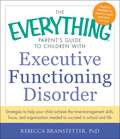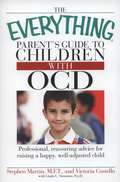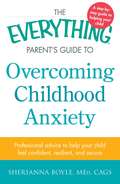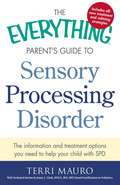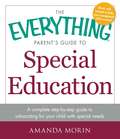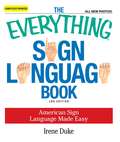- Table View
- List View
The Everything Parent's Guide To Children With Asperger's Syndrome: Help, Hope, And Guidance
by William StillmanWith The Everything Parent's Guide to Children with Asperger's Syndrome at your side, you'll take the first steps toward understanding this pervasive development disorder and how it may impact your child. This complete handbook for coping with daily life helps you:Get a diagnosis and understand the resultsDiscover the best options for education and learningWork to improve your child's social skillsIdentify triggers that lead to sensory overload, such as sounds, bright lights, or certain textures and fabricsRecognize symptoms of meltdowns and work with your child to prevent themEducate family and friends about Asperger's to provide a supportive and loving environmentExplore other resources, including reading lists, Web sites, and support groupsThe Everything Parent's Guide to Children with Asperger's Syndrome shows you how you can maintain a positive attitude, honor your child's unique experience, and strengthen the bond between you and your child.
The Everything Parent's Guide To Children With Bipolar Disorder: Professional, Reassuring Advice to Help You Understand And Cope
by William StillmanWhat does it mean for your child to be diagnosed with bipolar disorder? Where can you go to understand mood disorders, depression, and the highs and lows associated with this condition? The Everything Parent’s Guide to Children with Bipolar Disorder is an authoritative handbook designed specifically for parents with questions about their child’s emotional well-being, options for medication and therapy, and educational considerations.Author William Stillman helps you:Define bipolar disorderRecognize symptoms of mental health issuesFind a doctor and get a diagnosisHeighten awareness of depression, mania, and mood swingsMaintain healthy family relationshipsNavigate the teen yearsComplete with professional advice to help you cope with daily life, this all-inclusive resource provides reassuring answers for you and your child.
The Everything Parent's Guide To Children With Dyslexia: All You Need To Ensure Your Child's Success
by Abigail MarshallDyslexia affects 10 to 15 percent of the U.S. population. If you're the parent of a child with dyslexia you should read this book. The Everything(r) Parent's Guide to Children with Dyslexia, by Abigail Marshall gives you a complete understanding of what dyslexia.
The Everything Parent's Guide To Children With Dyslexia: All You Need To Ensure Your Child's Success
by Jody SwarbrickAlthough dyslexia affects 10 to 15 percent of the U.S. population, only 5 out of every 100 dyslexics are recognized and receive assistance. If you're the parent of a child with dyslexia, this statistic can be disconcerting, especially when it comes to your child's academic performance and developing social skills. The Everything Parent's Guide to Children with Dyslexia gives you a complete understanding of what dyslexia is, how to identify the signs, and what you can do to help your child. This authoritative book seeks to alert parents to the special needs associated with this learning disability and offers practical suggestions for getting involved in the classroom.The Everything Parent's Guide to Children with Dyslexia shows you how to:Select the right treatment programs for your childSecure an IEPChoose a school and reduce homework strugglesDevelop your child's skills with the use of assistive technologyMaintain open communication and offer supportThe Everything Parent's Guide to Children with Dyslexia is your first step in facing the challenges of dyslexia with a positive attitude.
The Everything Parent's Guide To Sensory Integration Disorder: Get the Right Diagnosis, Understand Treatments, And Advocate for Your Child
by Terri MauroFor kids living with Sensory Integration Disorder, the world can be a scary place, full of potentially stressful experiences. Kids with Sensory Integration Disorder can howl in discomfort over the feel of a shirt tag or a sock seam on bare skin. They may find the sound of a whisper to be as loud and frightening as a siren, and may perceive the caring touch of a parent or jostling in the school lunch line as equivalent to an assault.The Everything Parent's Guide to Sensory Integration Disorder:Provides an in-depth definition of Sensory Integration Disorder and explains its effectsHighlights occupational therapy treatments and explains techniques you can use outside of the therapist's office to calm your childIncludes helpful advice for parents teaching their children how to deal with this disorder at school, home, and play, from childhood through adulthoodIn The Everything Parent's Guide to Sensory Integration Disorder, you'll find the answers you need as you search for ways to help your child. This reassuring handbook examines various forms of treatment and therapy, and provides professional advice for helping children with SID succeed in school, at home, and with friends.
The Everything Parent's Guide to ADHD in Children: A Reassuring Guide to Getting the Right Diagnosis, Understanding Treatments, and Helping Your Child Focus
by Carole Jacobs Isadore WendelA reassuring guide to getting the right diagnosis, understanding treatments, and helping your child focus
The Everything Parent's Guide to Children With Dyslexia
by Abigail Marshall Jody SwarbrickAlthough dyslexia affects 10 to 15 percent of the U.S. population, only 5 out of every 100 dyslexics are recognized and receive assistance. If you're the parent of a child with dyslexia, this statistic can be disconcerting, especially when it comes to your child's academic performance and developing social skills. The Everything Parent's Guide to Children with Dyslexia gives you a complete understanding of what dyslexia is, how to identify the signs, and what you can do to help your child. This authoritative book seeks to alert parents to the special needs associated with this learning disability and offers practical suggestions for getting involved in the classroom.The Everything Parent's Guide to Children with Dyslexia shows you how to:Select the right treatment programs for your childSecure an IEPChoose a school and reduce homework strugglesDevelop your child's skills with the use of assistive technologyMaintain open communication and offer supportThe Everything Parent's Guide to Children with Dyslexia is your first step in facing the challenges of dyslexia with a positive attitude.
The Everything Parent's Guide to Children with Asperger's Syndrome
by William StillmanThe clinical diagnosis of Asperger's can be intimidating for parents. Often the focus is on their child's "disabilities" rather than his "abilities," and parents may be left wondering what they should expect as their child journeys through life. This guide helps you take the first steps toward understanding how this developmental disorder may impact your child. This uncomplicated handbook introduces you to Asperger's and helps you to:Get a diagnosis and understand the resultsIdentify triggers that can lead to sensory overloadRecognize symptoms of meltdowns and work to prevent themEducate family and friends about Asperger'sDiscover support groups for themselves and their childNow revised and updated, this new edition includes information on educational concerns and social interactions. This is the only resource you need to help your child overcome the obstacles of Asperger's and find success--and happiness.
The Everything Parent's Guide to Children with Asperger's Syndrome (The Everything®)
by William StillmanThe clinical diagnosis of Asperger's can be intimidating for parents. Often the focus is on their child's "disabilities" rather than his "abilities," and parents may be left wondering what they should expect as their child journeys through life. This guide helps you take the first steps toward understanding how this developmental disorder may impact your child. This uncomplicated handbook introduces you to Asperger's and helps you to:Get a diagnosis and understand the resultsIdentify triggers that can lead to sensory overloadRecognize symptoms of meltdowns and work to prevent themEducate family and friends about Asperger'sDiscover support groups for themselves and their childNow revised and updated, this new edition includes information on educational concerns and social interactions. This is the only resource you need to help your child overcome the obstacles of Asperger's and find success--and happiness.
The Everything Parent's Guide to Children with Autism
by Adelle Jameson Tilton Charlotte E. ThompsonLife with a child with autism can be challenging, exhausting, and - ultimately - very rewarding. For parents, even daily activities like getting dressed or grocery shopping can become daunting exercises. Children with autism require special strategies, and parents must learn how to think with their child instead of against him.This comprehensive guide offers practical advice, reassurances, and real-life scenarios to help families get through each day. You'll discover how to:Communicate effectively with their childFind a school that meets their child's needsHandle meltdowns in public or privateLearn about assistive devicesFind intervention and support groupsFull of useful information, expert advice, and positive techniques, this guide is the valuable tool you and your family need to make the most of every day - one interaction at a time!
The Everything Parent's Guide to Children with Dyslexia
by Abigail MarshallHelp your child succeed in the classroom--and in life! As a parent of a child with dyslexia you may wonder what you should expect as your child goes through life. How can you help your child deal with school and succeed? It's true, there are challenges for children with dyslexia, but when identified early, they can be overcome successfully. Abigail Marshall, manager of dyslexia.com, shows you how to: Identify the early symptoms of dyslexia. Work with teachers to create an Individualized Education Program (IEP). Reduce homework struggles. Find the best treatment program. Help your child develop skills with the use of assistive technology. Plan for college and career. The Everything Parent's Guide to Children with Dyslexia, 2nd Edition is your first step in facing the challenges of dyslexia with a positive attitude.
The Everything Parent's Guide to Children with Dyslexia: Learn the Key Signs of Dyslexia and Find the Best Treatment Options for Your Child
by Abigail MarshallHelp your child succeed in the classroom--and in life!As a parent of a child with dyslexia you may wonder what you should expect as your child goes through life. How can you help your child deal with school and succeed? It's true, there are challenges for children with dyslexia, but when identified early, they can be overcome successfully. Abigail Marshall, manager of dyslexia.com, shows you how to:Identify the early symptoms of dyslexia.Work with teachers to create an Individualized Education Program (IEP).Reduce homework struggles.Find the best treatment program.Help your child develop skills with the use of assistive technology.Plan for college and career.The Everything Parent's Guide to Children with Dyslexia, 2nd Edition is your first step in facing the challenges of dyslexia with a positive attitude.
The Everything Parent's Guide to Children with Executive Functioning Disorder: Strategies to help your child achieve the time-management skills, focus, and organization needed to succeed in school and life
by Rebecca BranstetterThe vital skills children need to achieve their full potential!Being organized. Staying focused. Controlling impulses and emotions.These are some of the basic executive functioning (EF) skills children need to function and succeed as they grow. But what can you do if your child is struggling with one or all of these skills? With this hands-on guide, you'll learn what EF difficulties look like and how you can help your child overcome these challenges. Psychologist Rebecca Branstetter teaches you how to help improve the executive functions, including:Task initiationResponse inhibitionFocusTime managementWorking memoryFlexibilitySelf-regulationCompleting tasksOrganization With checklists to help enforce skills and improve organization, The Everything Parent's Guide to Children with Executive Functioning Disorder is your step-by-step handbook for helping your child concentrate, learn, and thrive!
The Everything Parent's Guide to Children with OCD: Professional, Reassuring Advice for Raising a Happy, Well-adjusted Child
by Stephen Martin Victoria Costello Linda L. SimmonsIf you are the parent of one of the more than one million children with OCD, then you know what a confusing and disruptive disorder it can be. OCD can turn even simple tasks like homework and chores into almost impossible challenges. A child with OCD may feel stressed, worried, frustrated, frightened, and out of control.
The Everything Parent's Guide to Overcoming Childhood Anxiety: Professional Advice to Help Your Child Feel Confident, Resilient, and Secure
by Sherianna BoylePractical advice to help parents and kids cope with anxiety!All kids worry. But chronic worry can turn into frustration when it becomes the focus of your child's life. For some children, anxiety and fear are overwhelming and all-consuming. But with proper care and treatment, these kids can overcome paralyzing anxiety, learn long-term coping skills, and build resiliency. The Everything Parent's Guide to Overcoming Childhood Anxiety can help, with a hopeful outlook and expert advice on:Determining the causes and triggers of your child's anxiety.Understanding the difference between self-control and self-regulation.Finding the right treatments, including complementary approaches like nutrition, integrated therapy, and self-care.Educating and working with teachers and school officials.Assisting your child to create a confident, promising future. Best of all, implementing the practices found in this book can help you alter the course of your child's brain activity, changing beta high-frequency (hyperalert, fearful) brain waves to alpha (calming) waves. With this reassuring guide, you can rest easy knowing you have the information and resources you need to help your child feel competent, capable, and healthy.
The Everything Parent's Guide to Sensory Integration Disorder
by Terri Mauro Sharon A. CermakFor kids living with Sensory Integration Disorder, the world can be a scary place, full of potentially stressful experiences. Kids with Sensory Integration Disorder can howl in discomfort over the feel of a shirt tag or a sock seam on bare skin. They may find the sound of a whisper to be as loud and frightening as a siren, and may perceive the caring touch of a parent or jostling in the school lunch line as equivalent to an assault.The Everything Parent's Guide to Sensory Integration Disorder:Provides an in-depth definition of Sensory Integration Disorder and explains its effectsHighlights occupational therapy treatments and explains techniques you can use outside of the therapist's office to calm your childIncludes helpful advice for parents teaching their children how to deal with this disorder at school, home, and play, from childhood through adulthoodIn The Everything Parent's Guide to Sensory Integration Disorder, you'll find the answers you need as you search for ways to help your child. This reassuring handbook examines various forms of treatment and therapy, and provides professional advice for helping children with SID succeed in school, at home, and with friends.
The Everything Parent's Guide to Sensory Processing Disorder
by Terri Mauro Jenny L. ClarkIf your child has been diagnosed with sensory processing disorder (SPD), you understand how simple, everyday tasks can become a struggle. With The Everything Parent's Guide to Sensory Processing Disorder, you can help your child learn how to reduce stress and minimize the symptoms of SPD. In this all-in-one guide, Terri Mauro provides all the information you need regarding SPD, including: An in-depth definition of SPD and its effects. The newest treatments, therapies, and diets. Techniques for use outside of the therapist's office. The latest research on physical causes of SPD. Advice for coping at school, home, and play. Your child deserves to live a life free of the difficulties SPD can bring. The Everything Parent's Guide to Sensory Processing Disorder gives you professional advice to help your child to manage sensory needs and feel calmer, happier, and in control, now and in the future.
The Everything Parent's Guide to Sensory Processing Disorder: The Information and Treatment Options You Need to Help Your Child with SPD
by Terri MauroIf your child has been diagnosed with sensory processing disorder (SPD), you understand how simple, everyday tasks can become a struggle. With The Everything Parent's Guide to Sensory Processing Disorder, you can help your child learn how to reduce stress and minimize the symptoms of SPD. In this all-in-one guide, Terri Mauro provides all the information you need regarding SPD, including:An in-depth definition of SPD and its effects.The newest treatments, therapies, and diets.Techniques for use outside of the therapist's office.The latest research on physical causes of SPD.Advice for coping at school, home, and play. Your child deserves to live a life free of the difficulties SPD can bring. The Everything Parent's Guide to Sensory Processing Disorder gives you professional advice to help your child to manage sensory needs and feel calmer, happier, and in control, now and in the future.
The Everything Parent's Guide to Special Education
by Amanda MorinBe your child's best advocate! Children with special needs who succeed in school have one thing in common--their parents are passionate and effective advocates. It's not an easy job, but with The Everything Parent's Guide to Special Education, you will learn how to evaluate, prepare, organize, and get quality services, no matter what your child's disability. This valuable handbook gives you the tools you need to navigate the complex world of special education and services, with information on: Assessment and evaluation Educational needs for different disabilities, including multiple disabilities Current law, including the Individuals with Disabilities Education Act (IDEA) Working within the school system to create an IEP The importance of keeping detailed records Dealing with parent-school conflict With worksheets, forms, and sample documents and letters, you can be assured that you'll have all you need to help your child thrive--in school and in life!
The Everything Parent's Guide to Special Education: A Complete Step-by-Step Guide to Advocating for Your Child with Special Needs
by Amanda MorinBe your child's best advocate!Children with special needs who succeed in school have one thing in common--their parents are passionate and effective advocates. It's not an easy job, but with The Everything Parent's Guide to Special Education, you will learn how to evaluate, prepare, organize, and get quality services, no matter what your child's disability.This valuable handbook gives you the tools you need to navigate the complex world of special education and services, with information on:Assessment and evaluationEducational needs for different disabilities, including multiple disabilitiesCurrent law, including the Individuals with Disabilities Education Act (IDEA)Working within the school system to create an IEPThe importance of keeping detailed recordsDealing with parent-school conflict With worksheets, forms, and sample documents and letters, you can be assured that you'll have all you need to help your child thrive--in school and in life!
The Everything Parents' Guide to ADHD in Children
by Carole Jacobs Isadore WendelA roadmap to a common--but complicated--disorder.Is there a cure for ADHD?What symptoms should you be looking for?Could your child be misdiagnosed?When your child is diagnosed with ADHD, you want to do all you can to get the help you need to support your child. Unfortunately, the vast amount of information on ADHD can be overwhelming and leave you feeling frustrated, stressed, and powerless to help. But with the professional, accessible advice presented here, you can get the one-stop support you need to:Obtain and understand a diagnosisFind the right treatmentDiscipline your child effectivelyGet your child to focus at home and schoolStay positive, and encourage your childThis guide provides an all-encompassing look at ADHD so that you can feel confident about taking the necessary steps to create a better future for your child.
The Everything Parents' Guide to ADHD in Children
by Carole JacobsA roadmap to a common--but complicated--disorder.Is there a cure for ADHD?What symptoms should you be looking for?Could your child be misdiagnosed?When your child is diagnosed with ADHD, you want to do all you can to get the help you need to support your child. Unfortunately, the vast amount of information on ADHD can be overwhelming and leave you feeling frustrated, stressed, and powerless to help. But with the professional, accessible advice presented here, you can get the one-stop support you need to:Obtain and understand a diagnosisFind the right treatmentDiscipline your child effectivelyGet your child to focus at home and schoolStay positive, and encourage your childThis guide provides an all-encompassing look at ADHD so that you can feel confident about taking the necessary steps to create a better future for your child.
The Everything Sign Language Book: American Sign Language Made Easy... All new photos! (Everything®)
by Irene DukeThe appeal of American Sign Language (ASL) has extended beyond the Deaf community into the mainstream—it’s even popular as a class in high school and college. You are guided through the basics of ASL with clear instruction and more than 300 illustrations. With a minimum of time and effort, you will learn to sign: the ASL alphabet; questions and common expressions; numbers, money, and time. With info on signing etiquette, communicating with people in the Deaf community, and using ASL to aid child development, this book makes signing fun for the entire family.
The Everything® Parent's Guide To Children With Asperger's Syndrome
by William StillmanWith The Everything Parent's Guide to Children with Asperger's Syndrome at your side, you'll take the first steps toward understanding this pervasive development disorder and how it may impact your child.
The Everything® Parent's Guide To Children With Autism (2nd Edition)
by Adelle Jameson Tilton Charlotte E. ThompsonYou know that life with a child with autism can be challenging, exhausting, and—ultimately—very rewarding. When even daily activities like getting dressed or grocery shopping become daunting exercises, you need practical advice, expert reassurance, and real-life tips to help your family get through each day. The Everything Parent's Guide to Children with Autism, 2nd Edition has all that—and more! Children with autism require special strategies, and you must learn how to look beyond the autism diagnosis and appreciate your child's unique qualities. With this comprehensive guide, you'll discover how to: Communicate effectively with your child Find a school that meets your child's needs Handle meltdowns in public or private Learn how diet can affect your child's health and behavior Find intervention and support groups Full of useful information, expert advice, and positive techniques, The Everything Parent's Guide to Children with Autism, 2nd Edition is the valuable tool you and your family need to make the most of every day—handling the challenges with confidence and taking time to savor the rewards of life with your child.Show more
